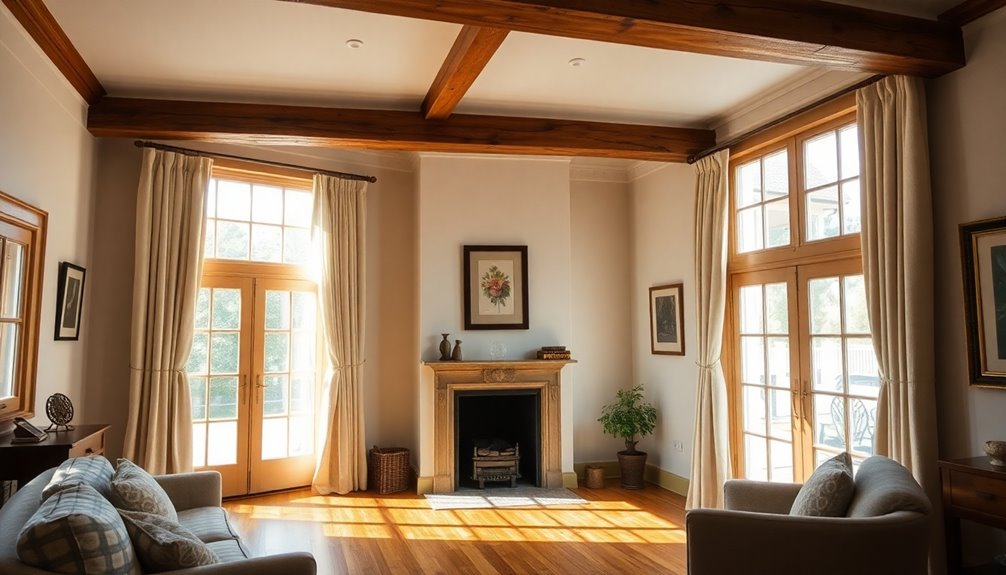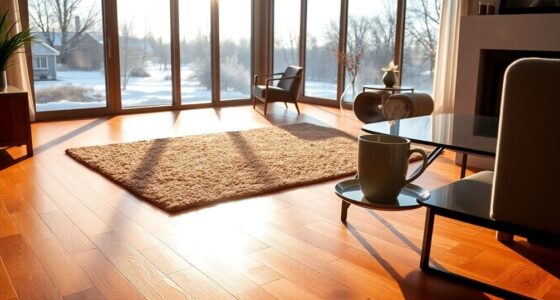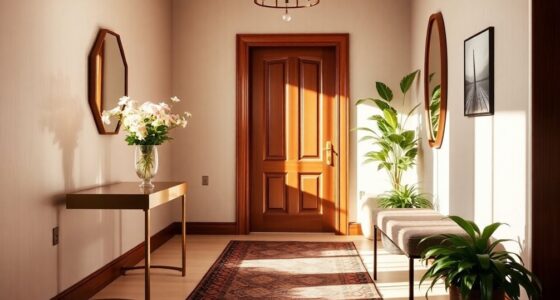To insulate your old home without losing its character, start by evaluating your current insulation and sealing air leaks around windows and doors. Choose suitable materials like cellulose for its eco-friendliness or spray foam for tight corners. Consider techniques such as the drill-and-fill method to add insulation while preserving aesthetics. Don’t forget moisture management and ventilation to guarantee comfort. Explore effective strategies that’ll help maintain your home’s charm and efficiency as you uncover even more options ahead.
Key Takeaways
- Use drill-and-fill insulation techniques to enhance energy efficiency while preserving the original aesthetics of your home.
- Choose spray foam insulation for irregular spaces to ensure effective air sealing without altering the home’s character.
- Incorporate rigid foam panels during exterior renovations to improve insulation without impacting architectural integrity.
- Regularly inspect and maintain insulation and sealing to sustain efficiency and comfort over time.
- Prioritize moisture management with vapor barriers and effective ventilation to protect the home’s structure and appearance.
Understanding the Importance of Insulation in Older Homes

When you live in an older home, you mightn’t realize how much comfort and savings you’re missing out on due to inadequate insulation.
Proper insulation is essential, especially in pre-WWII homes, where existing insulation often falls short. Upgrading your insulation can greatly enhance energy efficiency, keeping warm air in during winter and blocking heat in summer. This not only improves your comfort but also reduces energy bills by hundreds annually. Additionally, good insulation helps maintain your home’s structural integrity by minimizing moisture issues and temperature fluctuations. Investing in professional insulation services can also boost your property value, making it a wise choice for any homeowner looking to improve their living space without compromising character. Moreover, well-insulated homes can significantly lower carbon emissions and contribute to a more sustainable environment.
Assessing Your Home’s Current Insulation

Upgrading insulation in your older home starts with understanding its current state.
Begin by identifying signs of poor insulation, like uneven room temperatures, cold walls, and drafts near windows and doors. High energy bills can also signal air leaks.
To get a thorough evaluation, consider hiring an energy auditor. They’ll use specialized tools to pinpoint potential issues with your existing insulation, checking for cracks or deterioration.
Consider hiring an energy auditor for a detailed assessment of your insulation, utilizing specialized tools to identify issues effectively.
Remember, older homes often face unique challenges, such as irregular framing and outdated wiring, which may require creative insulation solutions. Additionally, maximizing space can be crucial when deciding how to integrate new insulation without disrupting the home’s character.
Don’t overlook moisture management and verify your ventilation system is effective to prevent future problems before you add or upgrade insulation in your home.
Types of Insulation Materials for Old Houses

When it comes to insulating your old home, you’ve got some great options to contemplate.
Spray foam insulation stands out for its ability to fill irregular spaces and provide excellent air sealing.
On the other hand, traditional materials like batt and rigid panel insulation can still play an essential role in enhancing your home’s energy efficiency. Additionally, choosing insulation materials that offer air purification benefits can further enhance indoor air quality while preserving the character of your home.
Spray Foam Advantages
Spray foam insulation stands out as one of the most effective solutions for insulating old homes. It expands to fill irregular gaps, creating a robust air seal that considerably enhances energy efficiency. With a high R-value per inch, spray foam maximizes thermal resistance, even in tight spaces like walls and attics. Its waterproof properties help prevent moisture accumulation, reducing the risk of mold—essential for older homes. The minimally invasive application means you can upgrade insulation without major renovations, preserving your home’s character. Professional installation guarantees peak adhesion and effectiveness. Additionally, integrating smart utilities for home can further enhance energy efficiency and comfort in older homes.
| Benefit | Description | Importance |
|---|---|---|
| Energy Efficiency | Minimizes drafts | Lowers heating/cooling costs |
| Air Seal | Fills gaps and cracks | Enhances comfort |
| Moisture Prevention | Waterproof properties | Reduces mold risk |
| Thermal Resistance | High R-value per inch | Maximizes insulation |
| Minimally Invasive | Easy application | Preserves original structure |
Traditional Insulation Options
If you’re considering insulation options for an older home, traditional materials like cellulose, fiberglass batts, and rigid foam panels offer practical solutions.
Cellulose, made from recycled paper, effectively reduces air leaks and is often treated for fire resistance. You can use the drill-and-fill method to inject it into walls without extensive renovations, preserving your home’s character.
Fiberglass batts are a budget-friendly choice for DIY enthusiasts, available in various R-values, but they mightn’t seal air leaks as well as cellulose.
Rigid foam panels excel at insulating exterior walls and foundations, providing high energy efficiency and moisture resistance.
Carefully installing these panels is essential to maintain the aesthetic of your old home while enhancing its comfort. Additionally, choosing insulation materials that reduce allergens and pollutants can significantly improve indoor air quality.
Interior and Exterior Insulation Techniques

As you consider insulating an older home, understanding both interior and exterior techniques can enhance energy efficiency while preserving its unique character.
Here are key methods to explore:
- Drill-and-Fill Method: This involves drilling holes in your interior walls to inject loose-fill insulation, maintaining the original look.
- Closed-Cell Spray Foam: Use this for irregular spaces, as it provides excellent air sealing and moisture resistance without altering existing windows or architectural details.
- Exterior Insulation: During siding replacement, adding a continuous layer of rigid foam or mineral wool improves energy efficiency while preserving the architectural aesthetics of your home. Additionally, incorporating butter tools and accessories can further enhance your home’s comfort and energy efficiency during colder months.
Addressing Moisture and Ventilation Concerns

Proper moisture management is vital, as inadequate insulation can lead to water infiltration and humidity, increasing the risk of structural damage and mold growth. Installing vapor barriers tailored to your local climate helps prevent moisture buildup. Effective ventilation is key for maintaining indoor air quality and managing moisture issues, so consider adding exhaust fans and air vents. Regularly inspect and maintain flashing around windows and doors to address potential leaks. Finally, keep gutters and downspouts clear to direct water away from your foundation, further enhancing your home’s energy efficiency and safeguarding against moisture-related problems. Additionally, ensure proper ventilation to prevent dangerous gas buildup, like carbon monoxide which can pose serious health risks.
Cost-Effective Insulation Strategies for Old Houses

When it comes to insulating your old home, prioritizing attic insulation can save you a lot on energy bills. Before adding insulation, make sure you seal any air leaks to boost effectiveness and cut costs. Plus, combining insulation upgrades with other renovations can streamline the process and reduce labor expenses. Additionally, implementing water efficiency measures can further enhance the overall comfort and sustainability of your home.
Prioritize Attic Insulation
Prioritizing attic insulation can dramatically improve your home’s energy efficiency and comfort.
In older homes, effective insulation prevents heat loss and can lower heating bills by up to 50%.
Consider these options:
- Cellulose insulation: This material fills gaps effectively while providing a high R-value.
- Spray foam insulation: It offers superior air sealing and moisture resistance, enhancing insulation performance.
- Regular maintenance: Inspecting insulation guarantees it remains effective over time, especially since settling and moisture can degrade its quality. Additionally, incorporating geothermal heat pumps can further enhance your home’s energy efficiency by utilizing the Earth’s stable temperature for heating and cooling.
Seal Air Leaks
Effective attic insulation sets the stage for energy efficiency, but it’s just as important to seal air leaks throughout your home.
In older homes, drafts often sneak in through gaps around windows, doors, electrical outlets, and baseboards. By sealing air leaks, you can boost energy efficiency by up to 30%, greatly cutting heating and cooling costs.
To tackle this, grab some caulk or weatherstripping from your local home improvement store. These materials provide a simple and cost-effective solution for sealing air.
Don’t overlook your ducts—insulating and sealing around them can help prevent conditioned air from escaping. Additionally, incorporating energy-efficient water systems can further enhance the overall efficiency of your home.
Prioritize sealing air leaks before adding insulation to guarantee your efforts create a more comfortable living environment.
Combine Upgrades Efficiently
To maximize your investment in insulation upgrades, it makes sense to tackle multiple projects at once. Focus on these strategies:
- Start with the attic space—it’s often the most cost-effective area to insulate, leading to considerable energy savings.
- When replacing siding or roofing, combine these renovations with insulating walls for improved energy efficiency and reduced labor costs.
- Seal air leaks before adding insulation to fill gaps; this guarantees your home remains energy efficient and comfortable year-round.
Working with a good contractor can help you implement modern insulation techniques, like the drill-and-fill method, allowing you to upgrade without compromising your home’s character.
These efforts can notably lower your energy bills while enhancing comfort and value.
Frequently Asked Questions
How to Insulate a 100 Year Old House?
To insulate your 100-year-old house effectively, start by evaluating the attic, as improving its insulation can save you up to 50% on energy costs.
Consider spray foam insulation to fill gaps and create an air barrier. You might use the drill-and-fill method for existing walls or add rigid foam during siding work.
Don’t forget to seal air leaks around windows and doors to manage moisture and reduce drafts in your home.
How Did Ancient People Insulate Their Homes?
You might think ancient insulation methods were primitive, but they were surprisingly effective.
Ancient peoples used locally sourced materials like straw and mud for insulation, while Inuit communities built igloos from compacted snow, utilizing air pockets for warmth.
The Romans relied on thick stone walls to regulate temperature, and Native American tribes crafted earth shelters.
Even medieval Europeans used thatched roofs to trap air and provide insulation, showcasing their ingenuity in home design.
Do Old Houses Have Bad Insulation?
Yes, old houses often have bad insulation. Many were built without modern standards, leading to drafts and higher energy costs.
Over time, insulation materials can deteriorate, reducing their effectiveness. You might notice significant air leakage through natural ventilation systems, making these homes less energy-efficient.
If you’re living in an older home, upgrading the insulation can greatly improve comfort and cut heating bills, turning your space into a cozier environment.
Can Walls Be Insulated Without Putting up Drywall?
Imagine your home as a cozy blanket, protecting you from the chill outside.
Yes, you can insulate walls without putting up drywall! Techniques like injection foam or loose-fill insulation let you maintain that warmth while keeping your home’s character intact.
By drilling small holes, professionals can fill cavities with expanding foam or cellulose, enhancing energy efficiency without altering your walls.
It’s a smart, minimally invasive way to keep your space snug and inviting.
Conclusion
By embracing insulation, you’re not just wrapping your old home in warmth; you’re cocooning its history, preserving its character like a cherished heirloom. Each layer you add protects the stories embedded in its walls, allowing them to thrive for generations to come. Remember, a well-insulated home isn’t just about comfort; it’s about honoring the past while nurturing a future filled with love and laughter. So, go ahead—let your home shine brightly, wrapped in its cozy embrace.










